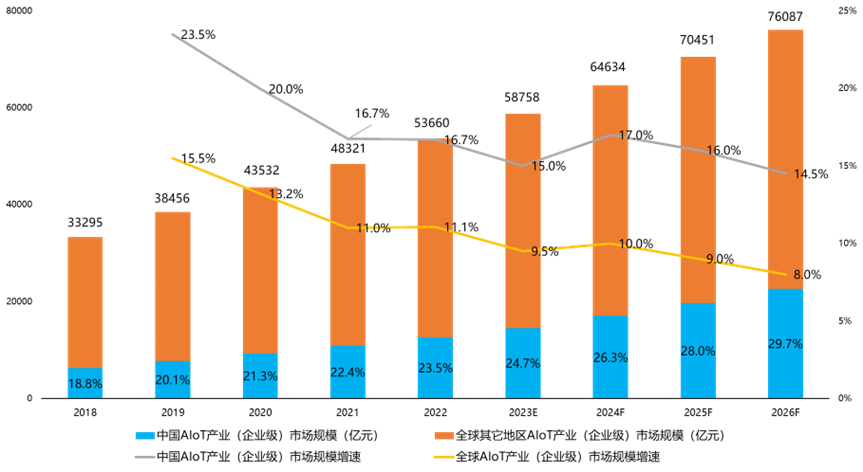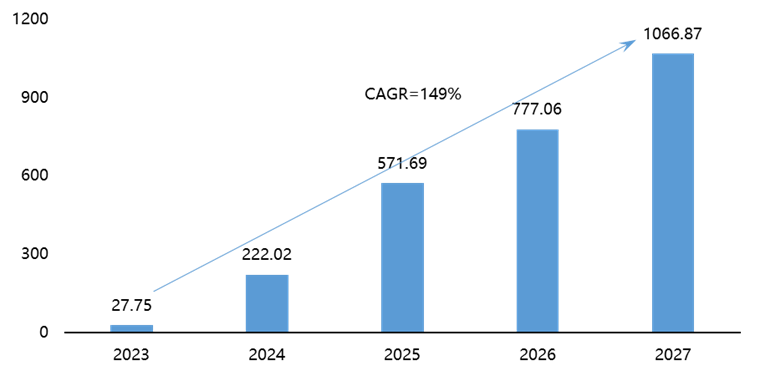

The Internet of Things (IoT), as a carrier of highly integrated and comprehensive application of new generation information technology, is widely applied in daily production and life, and plays an important role in the new round of industrial transformation and the green, intelligent, and sustainable development of the economy and society. As various industries have different operational mechanisms and numerous application scenarios, the rapid development of intelligent IoT (AIoT) has led to higher and more diversified requirements from different sectors for IoT. In addition to cellular connections, creating a high-quality Wi-Fi, Bluetooth, LoRa, and other short-range + long-range fully connected service system to meet the personalized connection needs of different industries has become an inevitable requirement in the era of intelligent IoT and the accelerated digital transformation of the economy and society.
1. Wi-Fi and Bluetooth are Two Important IoT Connection Methods
According to data released by organizations such as IoT Analytics and Zhi Ci Fang Research Institute, in 2022, the number of active IoT device connections worldwide was 14.3 billion, and it is expected to grow by 16% to 16.7 billion in 2023, reaching approximately 29.7 billion by 2027, with a compound annual growth rate of 16%; at the same time, from 2022 to 2026, the global AIoT industry (enterprise-level) market size is expected to grow at a compound annual growth rate of 9.1% to 7.6087 trillion yuan.
Chart 1: Global IoT Device Connection Scale from 2015 to 2027 (Unit: Billion)

Source: IoT Analytics
Chart 2: Global and China AIoT Industry (Enterprise-Level) Market Size and Growth Rate from 2018 to 2026

Source: Zhi Ci Fang Research Institute
Although the means of connection behind the IoT are rich and diverse, only a few technologies have formed large-scale applications after years of development. According to tracking data from organizations such as IoT Analytics, Ericsson, and ABI Research, the global IoT connections are dominated by four key technologies: Wi-Fi, Bluetooth, cellular networks, and LoRa, which together account for about 80% of the market share.
Among them, according to IoT Analytics statistics, Wi-Fi accounts for approximately 31% of all IoT connections. In 2022, more than half of Wi-Fi devices worldwide were based on the latest Wi-Fi 6 and Wi-Fi 6E technologies, and Wi-Fi technology and devices are continuously evolving, with Wi-Fi 7 being actively developed. Compared to Wi-Fi 6 and Wi-Fi 6E, Wi-Fi 7 can provide higher data transmission rates and lower latency. According to Fior Markets, the number of devices connected to Wi-Fi 7 is expected to reach 27.75 million in 2023 and exceed 1 billion by 2027. In all IoT scenarios, Wi-Fi technology is leading the IoT connections in smart homes, intelligent buildings, and healthcare.
Chart 3: Global Wi-Fi 7 Device Connection Numbers from 2023 to 2027 (Unit: Million)

Source: Fior Markets, compiled by Zhi Ci Fang Research Institute
Additionally, LoRa, as another important long-distance connection method, has a wide range of applicable scenarios and advantages such as long communication distance, wide coverage, and low power consumption. Currently, LoRa is the most widely used unlicensed spectrum wide-area communication network globally.
It can be seen that outside of cellular IoT, technologies such as Wi-Fi and LoRa have significant connection scales and high market shares, playing an important role in the development of the digital economy. Especially with the recent official announcement by the Wi-Fi Alliance to launch Wi-Fi CERTIFIED 7™, which begins the certification of Wi-Fi 7 devices to ensure that terminal devices can meet standard requirements and work well together. Currently, many leading chip and module manufacturers are accelerating the comprehensive layout of Wi-Fi 7 products.
The global leading IoT solution provider Quectel officially launched the communication modules FGE576Q and FGE573Q supporting Wi-Fi 7 and Bluetooth 5.3 (supporting 2Mbps BLE) during the 2024 International Consumer Electronics Show (CES), strongly promoting the global WLAN market into the Wi-Fi 7 era.
2. Wi-Fi 7 and BLE Technology Advantages Stand Out, Playing an Important Role in Digital Transformation
Wi-Fi has been used for many years in mobile phones, tablets, and personal computers due to its fast data transmission rates and high quality. As the construction of the Internet of Everything deepens, it is expected to be more widely applied in fields such as Wi-Fi AP/routers, smartwatches, smart homes, and intelligent buildings. The latest Wi-Fi 7 introduces larger wireless bandwidth (320MHz), higher-order modulation (4096-QAM), more flexible spectrum utilization (MRU, multi-resource unit), higher space-time reuse (16×16 MIMO), more link operations (MLO), and multi-AP collaboration among other new technologies, allowing Wi-Fi 7 to provide higher data transmission rates and lower latency:
-
Faster: Nearly 4 times the performance of wireless data links, expected to support approximately 3 times the data throughput of Wi-Fi 6 within the same time.
-
More reliable: The new MRU reduces multi-user latency by 25%.
-
More stable connections: The new MLO reduces single-user latency by 80%, with throughput gains of up to 300%.
-
New frequency band: Wi-Fi 7 introduces the new 6GHz frequency band (5.925GHz-7.125GHz), increasing maximum bandwidth to 320MHz to meet the high throughput/low latency requirements of 4K video, AR/VR, etc.
Chart 4: Performance Comparison of Wi-Fi 5, 6/6E, and 7 Versions

Source: H3C, Shen Gang Securities
The multi-link operation, multi-AP collaborative scheduling, time-sensitive network, and enhanced retransmission mechanism of Wi-Fi 7 provide it with more efficient and flexible characteristics.
-
MLO defines two working modes: synchronous and asynchronous. In synchronous mode, the multi-link synchronization of MLD performs TX/RX operations, avoiding interference between two links. In asynchronous mode, there are no strict timing requirements between multiple links.
-
Multi-AP coordination is proposed, which is more conducive to collaborative orthogonal frequency division multiple access, collaborative spatial reuse, collaborative beamforming, and collaborative data transmission.
-
HAQR (Hybrid Automatic Repeat Request, a method combining forward error correction and automatic repeat requests) allows for combined decoding of first transmission packets and retransmitted packets, improving the efficiency of successful decoding.
BLE not only has good device compatibility and supports various radio options, adapting to various peripheral devices, enabling developers to build products that meet their customers’ unique connection needs. In recent years, it has continuously improved in energy saving, ranging, and data transmission technologies, laying a solid foundation for its large-scale application promotion. After integrating mesh networking technology, it can also achieve large-scale network connections with obvious application advantages.
LoRa has seen rapid development in China in recent years. Based on its advantages in flexible networking, it is moving towards industrialization and standardization, with accelerated integration of upstream and downstream resources in the industry chain, continuously promoting improvements in transmission security and reductions in power consumption; application directions are gradually focusing on emerging popular application scenarios including robotics, wearable devices, smart supply chains, positioning and navigation, and many other fields.
As the digital transformation of the economy and society deepens and the digital industrial chain matures, the IoT continues to integrate with social production and life, and the demand for industry applications has become more diversified, raising higher and more diverse requirements for coverage, cost, and latency. Often, a single communication technology can no longer solve these challenges. Wi-Fi and Bluetooth short-range transmission, combined with cellular IoT and LoRa long-range IoT technologies, provide fully connected application services that efficiently meet the connection needs of different application scenarios.
The integration networking solutions of Wi-Fi 7, BLE, and cellular IoT with LoRa should emerge in response to market demands, with all parties forming a complementary and deeply integrated trend, combining various communication technologies in more communication application scenarios to achieve better cost-effectiveness and meet more fragmented industry needs.
3. Quectel’s Wi-Fi 7 Module New Products Set a New Industry Benchmark, Empowering High-Quality Digital Development
On January 9, during the 2024 CES conference, Quectel officially launched the communication modules FGE576Q and FGE573Q supporting the latest Wi-Fi 7 technology standards, which can provide higher transmission rates, larger connection capacity, and better communication efficiency, possessing many of the aforementioned Wi-Fi 7 technological advantages to easily meet the growing demand for wireless communication capabilities in smart homes, industrial automation, healthcare, transportation, and other fields.
Chart 5: Quectel’s Wi-Fi 7 Modules FGE573Q and FGE576Q

Source: Quectel
High rates and low latency will provide users with an unprecedented smooth experience
In terms of the network connection rate that the market is most concerned about, these two modules perform excellently, with FGE576Q achieving a data transmission rate of up to 3.6Gbps, supporting dual-band concurrency of 2.4GHz + 5GHz and 2.4GHz + 6GHz, while FGE573Q offers a rate of up to 2.9Gbps. Additionally, both Wi-Fi modules adopt multi-link operation functionality. Through this functionality, routers can utilize multiple wireless bands and channels concurrently when connecting to Wi-Fi 7 clients, achieving greater throughput and lower latency, resulting in a qualitative leap in data transmission rates.
Furthermore, FGE576Q and FGE573Q also achieve the best coexistence state between Wi-Fi and Bluetooth, integrating dual-mode Bluetooth with a maximum rate of 2Mbps and supporting low-power audio and BLE features.
With outstanding communication performance and reliability, the FGE576Q and FGE573Q Wi-Fi 7 modules will provide users with an unprecedented smooth experience in emerging scenarios such as cloud gaming, 8K ultra-high-definition streaming, AR/VR, industrial IoT, and telemedicine.
Multiple encryptions ensure product safety and reliability
For wireless network connections, security is an important consideration that cannot be overlooked. The FGE576Q and FGE573Q adopt features such as WPA3 encryption to ensure the confidentiality and integrity of data transmission.
Moreover, from product architecture to firmware/software development, they follow industry-leading practices and standards, not only reducing potential vulnerabilities through independent testing by third-party organizations but also executing security practices such as generating SBOM and VEX files, and firmware binary analysis throughout the software development lifecycle to ensure product security and reliability.
Empowering customer product development with high flexibility and compatibility to reduce costs and increase efficiency
The FGE576Q and FGE573Q modules feature a compact design that helps customers seamlessly integrate them into various terminal devices; at the same time, these two modules have strong compatibility, effectively compatible with mainstream module sizes and product characteristics in the market, assisting customers in shortening terminal product development cycles and reducing costs.
To further facilitate the design process for customers, Quectel has also adapted various types of Wi-Fi/Bluetooth antennas for this series of modules, including YF0026AA, YEWT004AA, and YF0027CA, to meet different project requirements with high flexibility and compatibility. Additionally, Quectel can provide customized solutions for each project’s unique needs to further enhance customer terminal development efficiency.
It is also worth mentioning that at this conference, Quectel not only showcased the latest Wi-Fi 7 modules FGE576Q and FGE573Q but also launched the high-performance LoRa module KG200Z, which features long-distance transmission, ultra-low power consumption, high cost-effectiveness, and high reliability, meeting the critical needs of IoT devices for bidirectional communication, end-to-end security, mobility, and localized services.
The KG200Z module can transmit distances of 2-5 kilometers in urban environments and up to 10-15 kilometers in suburban areas; it supports the LoRaWAN standard protocol, designed for various ultra-low-power IoT applications, significantly extending the battery life of IoT terminals; it features rich peripheral interfaces such as UART, SPI, I2C, and SWD, along with reliable security guarantees, meeting various application needs.
The KG200Z is particularly suitable for power-sensitive applications that require intermittent low-rate messaging over long distances, such as smart locks, gas and water leak detection, air quality monitoring, HVAC monitoring, smart parking and traffic monitoring, utility metering, waste management, and asset tracking.
Chart 6: Quectel’s LoRa Module KG200Z

Source: Quectel
4. Conclusion
Globally, the rapid development of technologies such as IoT, big data, and computing power is injecting strong momentum into the digital transformation trends across various industries. In the fast-developing intelligent IoT (AIoT) era, wireless connections have become an indispensable part of daily life and work. Online office, online education, online shopping, and other production and lifestyle modes are raising higher requirements for home network quality; cutting-edge application scenarios such as 4K/8K ultra-high-definition video, social gaming, and the metaverse are also imposing stricter demands on networks, necessitating continuous upgrades of Wi-Fi, Bluetooth, and other short-range transmission technologies, combined with cellular IoT and LoRa long-range IoT technologies to meet the increasingly diverse network demands.
As a leading module manufacturer deeply engaged in the IoT field for over a decade, Quectel has further enriched and upgraded its wide-area + local area, cellular + non-cellular product system by launching two Wi-Fi 7 modules and one LoRa module, strengthening its ability to provide high-quality fully connected application services, and setting a new benchmark for the development of the intelligent IoT industry.
Selected Articles


